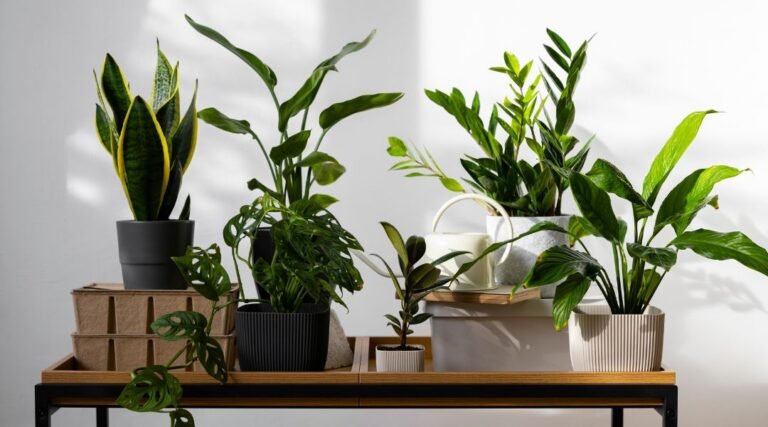
Best Indoor Plants for Improving Air Quality
Ensuring one’s health and mental stability is highly promoted by good indoor air quality. Respiratory infections, nausea, and respiratory problems are among the health problems that are brought about by inhaling polluted indoor air. However, planting flowers and indoor plants become a solution to clean air within these environments because they remove pollutants and toxins from the atmosphere Here are some examples of such plants:
Peace Lily (Spathiphyllum)
The Plant is known for absorbing a number of the aeriform impurities in the air, the reason behind being rated amongst the finest. It is effective in eradicating formaldehyde, benzene as well as other toxins from atmospheric air.
Its slim dark green leaves often stand out against elegant white blooms that are common within our indoor environment hence it is preferred for interior design purposes. Peace Lilies can be found growing wild or cultivated as houseplants; their requirement includes light ranging between low levels up to medium ones, while maintenance may demand watering at regular intervals.
Snake Plant (Sansevieria trifasciata)
Snake plant is the other name for mother-in-laws tongue which is a very low maintenance plant that has the ability to clean air from formaldehyde, benzene, toluene and trichloroethylene. Because of its tall and upright leaves plus its capability to grow in low light conditions, it is a perfect option for both offices and bedrooms. However, be aware that it is dangerous to pets such as dogs and cats.
Chrysanthemum
People choose Chrysanthemums for indoor plants because they have bright colors and can act as natural air filters by removing airborne contaminants. This makes them effective especially in eliminating some artificial substances like ammonia and benzene, which are often contained in plastics, detergents, and glue. Put them where they can access four hours direct sunlight every day at least while maintaining moisture at the root-zone levels.
Spider Plant (Chlorophytum comosum)
A spider plant is a perennial flowering plant native to tropical and southern Africa, also called Chlorophytum comosum or the airplane plant. It is well known for its purifying characteristics that make it favored among most houseplant cultivators. This plant is tough and gets long narrow leaves curving downwards with a lot of them being green with stripes that are either white or yellow, thus forming a round up to 60 cm wide bunch.
Spider Plants are highly admired, especially for their capability produce many spiderettes which dangle ot long stems and look like tiny spiders from where it derives its name. However, these offspring can be planted either in soil or water so as to increase their numbers.
In broad range of lighting conditions, they are most comfortable growing under bright shade and on soil with proper drainage properties. We know them for their strength, they can resist occasional negligence and unstable temperatures They even help purify indoor air absorbing toxins such as formaldehyde, xylene, and carbon monoxide Regular watering is obligatory; however, this plant will not die off during short dry spells to prevent it from overwatering and root rot. During the growth season in case they are healthy they can as well benefit from occasional feeding with a balanced liquid fertilizer.
Spider plants are favorite for offices and homes due to the fact that they have the utmost air purifying capabilities, good-looking foliage and they do not require a lot of attention.
Bamboo Palm (Chamaedorea seifrizii)
Bamboo palms go by their scientific name Chamaedorea seifrizii is one of the best houseplants thanks to its superior air-purifying properties that help cleanse airborne pollutants such as formaldehyde, as well as benzene.
It does well under dim light levels while needing little attention from you thus such a feature makes it an effective agent to add moisture into your home at all times which aids in creating an ideal growth condition even when you are not present for long hours. In addition, its long graceful bending leaves give a room that pure Kona feel found only at Hawaii’s finest stores; moreover, unlike other types of plants these beauties pose no danger at all if ingested by a dog or a cat hence are preferable for individuals living together with animals.
Dracaena (Dracaena spp)
Dracaena (Dracaena spp.) is considered one of the best indoor plants that can assist in purifying the air because they have the unique ability to filter and take away toxic substances such as formaldehyde, benzene, trichloroethylene, and xylene from it. They generally flourish well under dim to moderate light intensities with little attention needed to keep them healthy; thus making their cultivation indoors effective. In addition to improving room appeal due to their multiform leaves, various species of this plant provide other benefits.
Aloe Vera (Aloe barbadensis)
There is this great plant that you can use grow indoors to make the air cleaner it is called Aloe Vera (Aloe barbadensis). It can survive in different lighting conditions; require less water thus easy t care thus very suitable for indoor species. Even in addition, Aloe Vera gives some extra advantages which include offering a cooling gel that could be used for light burns as well as irritations of the skin. This therefore means that it is a useful plant in homes because aside from its decorative purposes, it also has health benefits related to a number of diseases and pollution due to some gases that we are in contact with.
Barberton Daisy (Gerbera jamesonii)
Barberton Daisy otherwise known by its scientific name Gerbera jamesonii makes a great choice of indoor plant since it cleans the air by getting rid of such air pollutants as benzene, formaldehyde or trichloroethylene from it. This flower has attractive and lovely petals which beautify houses and at the same time, creates conducive environment for habitation in our homes.
Barberton Daisies can be kept indoors or out in full sun or shade; they need only moderate care which makes them a manageable yet highly beneficial addition to any home. They are one of the best choices for individuals aiming at improving both the physical and visual conditions of a building because they purify it of air.
English Ivy (Hedera helix)
Its proficiency in purification of air in the indoors by cleansing toxic elements like benzene, formaldehyde, xylene, and mold spores, makes English Ivy (Hedera helix) a suitable indoor plant for freshening it up. This adaptable and low-maintenance plant can grow in various lights, therefore being fitting for diverse rooms.
The English Ivy is relatively easy to take care of, it needs watering from time to time and pruning. Its air cleaning properties are also great, this is why it’s among the best plants that can improve the quality of air indoors. With regard to appearance with respect to purfication, these qualities make it a preferred choice to improve indoor air characteristics.
chrysanthemum ( indoor plants )
Mum is a common name for the flower called chrysanthemum, which can filter various substances like benzene, trichloroethylene, formaldehyde, xylene and even ammonia, and this makes it one of the best indoor plants at increasing air quality. Its vivid flowers make indoor spaces more beautiful while also keeping them healthier.
Chrysanthemums grow well in places where there is enough bright light but not under direct sunlight and they are also not high maintenance which makes them a great choice for both aesthetics and functional air purification. Their appeal is threefold: they adorn rooms while cleaning up contaminants thus offering a top solution for perfectionists willing to improve their indoor atmosphere
In conclusion, It is very important for the wellbeing of our health, both physically as well as mentally that indoor air quality should always be maintained clean. When this is done using flowers and plants especially at home; they help a lot in purifying pollutants which we find harmful when breathed into our bodies like SO2, CO etc.
This way enables one to choose out from among many varieties such as herbs or trees that are used among others so as to help someone become ok again just by taking care of themselves even in their houses thus contributing towards avoiding additional hospitalization costs.
Related article: A Complete Guide to Growing and Caring for Jewel Orchids




